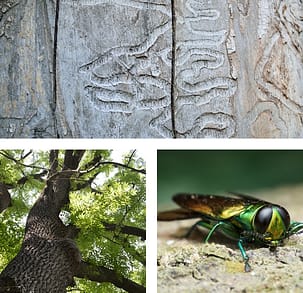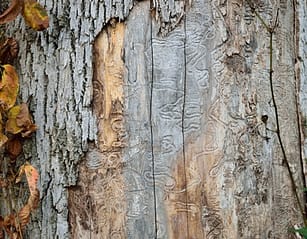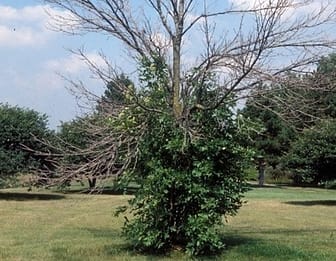Have you been noticing that your ash trees are dying but aren’t sure why? It’s possible that you have an Emerald Ash Borer Beetle infestation in your yard that needs to be serviced by professionals as soon as possible.
What Is The Emerald Ash Borer Beetle?
 The Emerald Ash Borer is an invasive species that originated in Central Asia and was first seen in the US in the early 2000s. Adult Emerald Ash Borers are metallic green in color, flat on the back, and approximately the size of one grain of cooked rice.
The Emerald Ash Borer is an invasive species that originated in Central Asia and was first seen in the US in the early 2000s. Adult Emerald Ash Borers are metallic green in color, flat on the back, and approximately the size of one grain of cooked rice.
Their larvae can be found underneath tree bark and are cream-colored with pincher-like appendages. Adult beetles emerge from underneath the bark in late May through mid-July but will cause little damage to the actual tree itself.
How Are Emerald Ash Borers Harmful?
If adult beetles don’t destroy ash trees, how is the species invasive?
The real problem with these insects is when they begin to repopulate. As the beetles mate and reproduce, they breed more and more larvae. This larva continues to live in and feed on the tree’s inner bark.
This process disrupts the ash tree’s ability to transport water and nutrients, resulting in the death of millions of Ash trees across the US. This problem is so severe that the USDA has begun to enforce quarantines to prevent the spread of the Emerald Ash Borer Beetles across the country.
Ash Tree Identification: What Does An Ash Tree Look Like?
Ash trees are one of the most populous trees in the United States, and it is likely you have seen them before or have them in your backyard.
Here are several ways to identify if the trees you think are  infested with Emerald Ash Borers are actually ash trees.
infested with Emerald Ash Borers are actually ash trees.
- Ash trees have opposite branching – which is where two branches stretch out and grow from the first branch. These branches are parallel to one another.
- Ash trees have leaves that are compound – meaning that they typically consist of 5-11 leaflets
- Seeds – when present and able to be seen, appear in paddle-like clusters.
- The bark on older ash trees often has a distinct diamond pattern. Additionally, it is typically very rough to the touch, contrasting the very smooth bark of young ash trees.
How Do I Know If My Ash Trees Are Infected?
There are several ways to identify an Emerald Ash Borer infestation that do not involve directly seeing the beetle or larvae.
- Dead Branches: When the Emerald Ash Borer Beetle eats away at the inside of the ash trees it prevents the flow of nutrients to the tree’s branches. This results in branches at the top of the canopy beginning to die off, which you will be able to notice very easily.
- Woodpeckers: Woodpeckers are the only known predator of the Emerald Ash Borer Beetle in North America. If you are starting to see an abnormally high amount of woodpeckers around your ash tree, this could be a sign of infestation.
- D-shaped Holes in Bark: When larvae emerge from underneath the tree bark, they make D-shaped holes in the wood. While not visible until later in the infestation process, these holes are another clear sign of an Emerald Ash Borer infestation.

- S-shaped Larvae Galleries: Similar to the D-shaped holes larvae make when they emerge from beneath the tree bark, Emerald Ash Borer larvae leave S-shaped galleries when they feed. This pattern alone, or in conjunction with another sign, are distinctive indicators that you have an infestation.
- Vertical Bark Splits: As an Ash tree dies, its bark may split open. This is a result of the larvae moving and feeding underneath it for so long. Furthermore, if you are able to look under these bark splits, you may be able to see the larvae themselves to confirm your suspicions of an infestation.
- New Branches at the Base: As the Ash tree tries to fight off the beetle infestation to prevent itself from dying, you might see new branches at its base. This is because this part of the tree is still able to reach nutrients and it is trying to grow in order to stay alive.
What Should You Do If You Think You Have An Emerald Ash Borer Infestation?
If you think your trees are being infested by Emerald Ash Borer Beetles, you should contact Ed’s Tree Service for assistance with high-quality tree and infestation removal. Our tree care professionals are trained to help prevent the spreading of the Emerald Ash Borer epidemic and keep your trees healthy. Ecologically, it’s vital to stay on top of your tree’s health, and seeking professional help is the best way to ensure the overall safety of your yard.
How To Get Rid of The Ash Borer Beetle
Due to the infectious nature of the Emerald Ashe Borer Beetle, the USDA has very strict guidelines for the quarantining and disposing of Ash Trees, as it is vital to ensure the tree disease does not spread. By seeking professional Ash Tree removal, you can ensure that these regulations are followed and not have to worry about the infestation returning.
Getting expert help from Ed’s Tree Service is especially vital if your tree is located in an area around others. This is because infestation can spread easily to trees around it, putting entire neighborhoods at risk if not disposed of properly. Ash trees are known for having brittle wood and a fallen tree can easily cause damage to houses, powerlines, and anything else in its path. To avoid having to deal with the legal and financial ramifications of this, reach out to Ed’s Tree Service for Ash tree and Emerald Ash Borer removal assistance.





